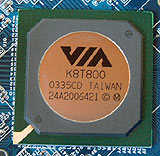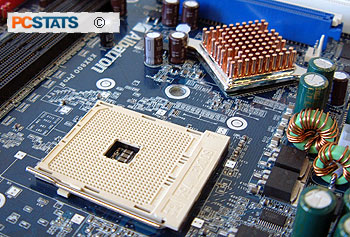 VIA's very popular chipset for the Athlon64 is called the K8T800, and it is
offered in two varieties; a server/workstation version for the socket
940 Opteron/Athlon64 FX processor, and the Performance PC
platform for the socket 754 Athlon64 CPU.
VIA's very popular chipset for the Athlon64 is called the K8T800, and it is
offered in two varieties; a server/workstation version for the socket
940 Opteron/Athlon64 FX processor, and the Performance PC
platform for the socket 754 Athlon64 CPU.
Both
versions of VIA's core logic typically come
bundled with the new VT8237 Southbridge. The major
selling point for
VIA's chipset is that it features a faster Hypertransport link (800Mhz DDR
for an effective 1.6Ghz) between the CPU and the chipset than the offerings
from the other companies like Ali and Nvidia.
As the K8T800 uses a 16-bit (meaning 16bits of
data in each Hypertransport packet) link, this enables the path to
reach a maximum bandwidth of 3.2GB/s (1.6Ghz * 16 / 8) in each direction for a
rather impressive maximum theoretical bandwidth of 6.4GB/s. VIA proposition that problems with
signal interference have forced many of their competitors to resort to using
lower speed implementations of Hypertransport, a problem which they have resolved
with their "Hyper8" technology.
Socket 754, and new Thermal Solutions
for the Athlon64
With the release of the Athlon64 we are
finally saying good bye to the venerable Socket 462/A platform. AthlonXP 3200's
and Athlon64 3200's may only differ in name slightly, but the physical changes
are enormous. To accommodate the nearly 106 million transistors packed into a
193mm2 die on the Athlon 64 3200+ processor, and the roughly 80W heat output,
AMD have migrated to an entirely new cooling platform.
 The plastic retention frame now used with every Athlon64 processor, on both Socket 754
and Socket 940, is made of glass-filled Lexan, and provides a very firm place
for the Athlon64 heatsink to grip onto.
The plastic retention frame now used with every Athlon64 processor, on both Socket 754
and Socket 940, is made of glass-filled Lexan, and provides a very firm place
for the Athlon64 heatsink to grip onto.
Curiously, the Albatron K8X800 Pro II we received for
testing lacked the frame,
but that shouldn't be a problem as virtually every heatsink being sold
for K8 processors does come with one.
The new
K8 heatsinks apply upwards of 75lbs force on the Athlon64 processor so there is
one more piece of the equation which is new to the AMD arena. Round back of the motherboard
you will find a metal plate about the
size of a deck of cards. It is called the "backplate sub-assembly"
and it is placed directly behind the socket
to keep the motherboard from warping.
